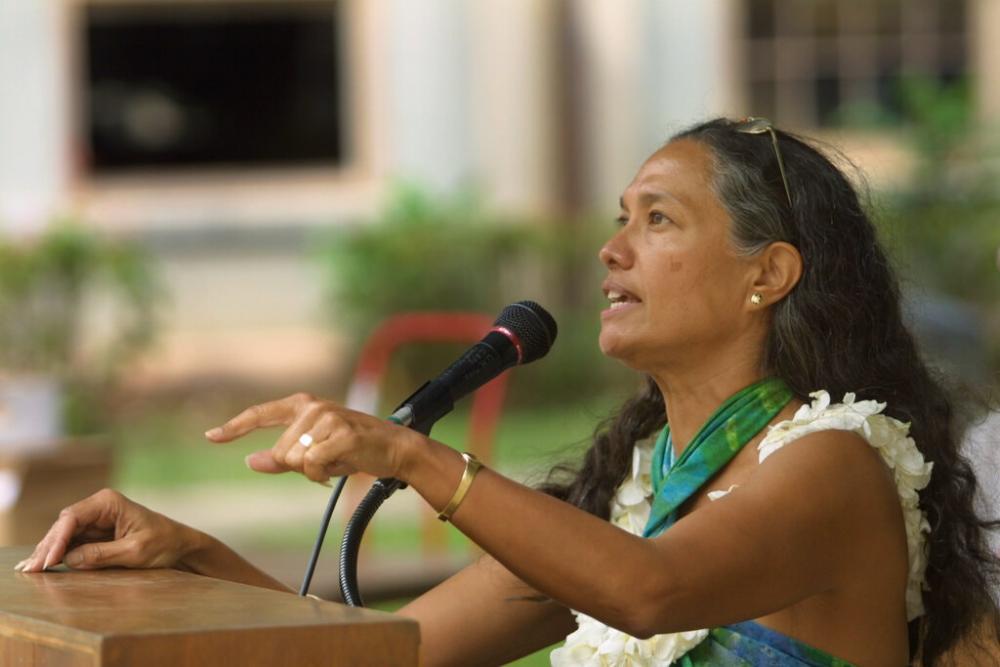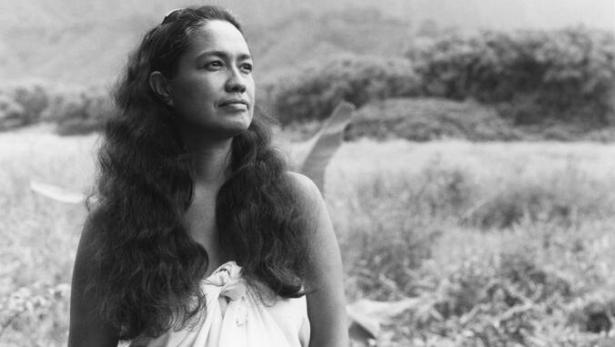Haunani-Kay Trask, a scholar, poet and champion of sovereignty for the Hawaiian people who decried what she called the colonization and despoliation of her native land, died on July 3 in Honolulu. She was 71.
The cause was cancer, her partner, David E. Stannard, said.
In her best-known book, “Notes From a Native Daughter: Colonialism and Sovereignty in Hawaii” (1993), Dr. Trask called Hawaii “once the most fragile and precious of sacred places, now transformed by the American behemoth into a dying land.”
“Only a whispering spirit remains,” she wrote.
Dr. Trask was not afraid to make waves as a leader of what became known as the Hawaiian Sovereignty movement. She received national attention in 1990 for remarks directed at an undergraduate student at the University of Hawaii, where she was a professor of Hawaiian studies. The student, in a letter to the school newspaper, accused Native Hawaiians of holding racist attitudes toward white people on the island.
Dr. Trask responded that the student “does not understand racism at all” and should leave Hawaii — which he did, returning to his home state, Louisiana, for a time, The New York Times reported. When some students and faculty members criticized Dr. Trask’s comments as unnecessarily harsh, she answered: “I am a nationalist. I am asserting my claim to my country.”
She continued, “I am not soft, I am not sweet, and I do not want any more tourists in Hawaii.”
With her sister Mililani B. Trask, Dr. Trask was a founding member of Ka Lahui Hawaii, an organization that promotes self-determination for Native Hawaiians, which held its first convention in 1987. She believed, as she wrote in “Notes From a Native Daughter,” that “the secrets of the land die with the people of the land,” and thus that preservation of Indigenous lands should be paramount.
In 1993, she helped lead a march of Native Hawaiians, known as Kanaka Maoli, who were seeking to reclaim lands held in trust by the state. The march, one of the first major protests calling for a return of native lands in Hawaii, took place on the centennial of the overthrow of its last queen, Liliuokalani.
Ka Lahui demanded that the territory be ceded to it, after it had drawn up a constitution for Hawaiian self-government along the lines of the “nation within a nation” model found in American Indian tribal lands. Bills were introduced in the state Legislature, but they failed to pass.
At the march, Dr. Trask took to the podium in front of Honolulu’s Iolani Palace and proclaimed: “We are not American. We will die as Hawaiians. We will never be Americans.”
She continued: “The Americans, my people, are our enemies, and you must understand that. They are our enemies. They took our land, they imprisoned our queen, they banned our language, they forcibly made us a colony of the United States.”
In addition to “From a Native Daughter,” her books include “Eros and Power: The Promise of Feminist Theory” (1981), which was adapted from her dissertation, and two poetry collections, “Light in the Crevice Never Seen” (1994) and “Night Is a Sharkskin Drum” (2002).
Dr. Trask’s poetry employed imagery suggestive of a sentient island bleeding from the violence of colonialism. In one poem, “Colonization,” she wrote:
Hawaiian at heart:
nothing said
about loss
violence, death
by hundreds of thousands.
She also railed against the tourism industry, in her poetry as well as her academic work. She challenged its marketing of the Hawaiian islands as an acquiescent paradise, a depiction that she felt ignored the history of violence against the land and its Native inhabitants.
Hawaii is a racially diverse society: 2019 census data puts the island at about a quarter white, 38 percent Asian, 10 percent Native Hawaiian and another quarter identifying with two or more races. Large numbers of Japanese immigrants came to Hawaii in the late 19th and early 20th centuries; with American annexation of the island in 1898, white settlers came as well. Hawaii became a state in 1959.
Dr. Trask was founding director of the University of Hawaii’s Kamakakuokalani Center for Hawaiian Studies, a field she was credited with helping to establish. She retired from the university in 2010.
She was considered a pivotal figure in showing “the importance of critical analysis and creativity to forging a more just future for Indigenous peoples,” the American Academy of Arts and Sciences said in electing her a member this year.

Credit: Hawaii Star-Advertiser // New York Times
Haunani-Kay Trask was born on Oct. 3, 1949, in San Francisco to Bernard Kaukaohu Trask and Haunani (Cooper) Trask. Her mother taught elementary school, and her father was a lawyer.
“When I meet another Hawaiian,” Dr. Trask wrote of her lineage, “I say I am descended of two genealogical lines: the Piilani line through my mother, who is from Hana, Maui, and the Kahakumakaliua line through my father’s family from Kauai.”
She grew up on Oahu, outside Honolulu, along with her five siblings.
She graduated from the Kamehameha School in Honolulu, which was established in the late 19th century to educate children of Hawaiian descent. She attended the University of Wisconsin at Madison, earning her bachelor’s degree in political science in 1975 and a doctorate in the same field in 1981.
Just after completing her Ph.D., Dr. Trask began teaching at the University of Hawaii at Manoa, where she started in the American studies department.
Along with Dr. Stannard, her partner since 1980, and her sister Mililani, she is survived by two other sisters, Kahala-Ann Trask Gibson and Damien Onaona Trask, and a brother, Michael. She died in a residential care home.
In her speech at the 1993 march in Honolulu, Dr. Trask summed up much of what her life was about when she reminded her fellow protesters why she stood before them, and what drove her on. “I am so proud to be here,” she said.
“I am so proud to be angry. I am so proud to be a Hawaiian.”
[Annabelle Williams is a proud Philadelphian and a 2020 graduate of the University of Pennsylvania. She has worked at The Philadelphia Inquirer, New York magazine, The American Prospect and Business Insider. She has also written for The Washington Post. She led Penn’s student magazine, 34th Street.]


Spread the word